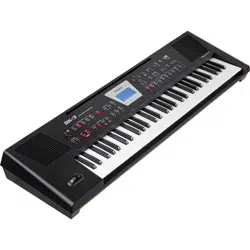Loading ...
Loading ...
Loading ...

Menu options
56
For some sounds, negative (–) “Resonance” settings may
produce no noticeable change because the resonance is already
set to the minimum value.
The following parameters allow you to set the sound’s “envelope”.
The envelope parameters aect both the volume (TVA) and the
lter (TVF). The cuto frequency will rise as the envelope rises and
fall as the envelope falls.
Attack (T)
This parameter adjusts the onset of the sound. Negative values
speed up the attack, so that the sound becomes more aggressive.
Parameter Setting
Attack -127~0~+127
Decay (T)
This parameter adjusts the time over which the sound’s volume and
cuto frequency fall from the highest point of the attack down to
the sustain level.
Parameter Setting
Decay -127~0~+127
NOTE
Percussive sounds usually have a sustain level of “0”. Piano and
guitar sounds are in this category. Holding the keys for a long
time will have little eect on the duration of the notes you are
playing, even if you select a high value here.
Release (T)
This parameter adjusts the time over which the sound will decay
after the note is released until it is no longer heard. The cuto
frequency will also fall according to this setting.
Parameter Setting
Release -127~0~+127
NOTE
Some sounds already contain natural (sampled) vibrato whose
depth or speed cannot be changed.
Use the following three parameters if you think the instrument in
question has too much (or could use a little more) vibrato.
Vibrato Rate (T)
This parameter adjusts the speed of the pitch modulation. Positive
(+) settings make the preset pitch modulation faster, and negative
(–) settings make it slower.
Parameter Setting
Vibrato Rate -127~0~+127
Vibrato Depth (T)
This parameter adjusts the intensity of the pitch modulation.
Positive (+) settings mean that the “wobble” becomes more
prominent, while negative (–) settings make it shallower.
Parameter Setting
Vibrato Depth -127~0~+127
Vibrato Delay (T)
This parameter adjusts the time required for the vibrato eect to
begin. Positive (+) settings increase the time before vibrato will
begin and negative settings (–) shorten the time.
Parameter Setting
Vibrato Delay -127~0~+127
Mfx
The BK-3 contains 2 multi-eects processors (“Mfx”), one reverb
processor and one chorus processor that can be used to process
rhythms or Standard MIDI Files.
Select “O” for instruments that don’t need to be processed by any
Mfx.
Parameter Setting
Mfx O, A, B
MEMO
If you select “A” or “B”, additional parameters can be edited (see
below).
Mfx Type
Allows you to select the desired Mfx type, i.e. the kind of eect you
need. Each Mfx (“A” and “B”) can be assigned to as many instruments
as you like. Be aware, however, that selecting a dierent type will
aect all instruments that use this Mfx processor. For a list of the
available Mfx types see p.. 45.
NOTE
Each Mfx can be assigned to as many instruments as you like.
Be aware, however, that selecting a dierent type will aect all
instruments that use this Mfx processor.
NOTE
While the “Mfx” parameter is set to “O”, you cannot select a
dierent type. In that case, the display will show the message
“---”.
Mfx Edit
If you also want to edit the parameters of the selected eect
type, press the [ENTER] button to jump to the “Mfx Edit” page.
You can then edit the available parameters.
Equalizer
Activate this setting if you want to change the timbre of the
selected instrument.
Parameter Setting
Equalizer O, On
Edit EQ
To edit the equalizer parameters, press the [ENTER/] button to jump
to the “Edit EQ” page. You can then edit the available parameters:
Parameter Setting Explanation
Equalizer O, On
Activate this setting if you want to
change the timbre of the selected
instrument.
This parameter duplicates the
“Equalizer” above and was added for
your convenience.
High Freq
1500 Hz, 2000 Hz,
3000 Hz, 4000 Hz,
6000 Hz, 8000 Hz,
12000 Hz
Allows you to set the cuto frequency of
the high band (this is a shelving lter).
High Gain –15~+15 dB
Use this parameter to set the level of
the selected “High” frequency. Positive
values boost (increase the volume of)
that frequency, negative values cut
(attenuate) it.
Mid Freq 200~8000 Hz
Allows you to set the cuto frequency of
the middle band (this is a peaking lter).
Loading ...
Loading ...
Loading ...
